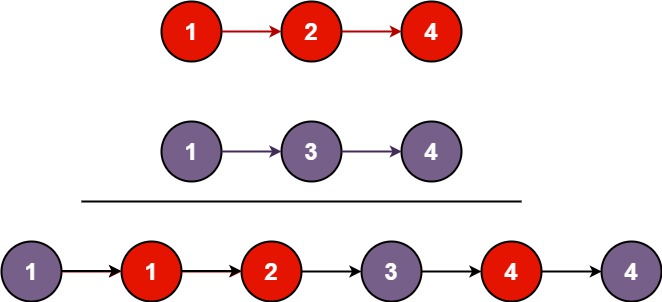Suggested Problems
Leetcode - 21. Merge Two Sorted Lists

Problem Description
You are given the heads of two sorted linked lists list1 and list2.
Merge the two lists into one sorted list. The list should be made by splicing together the nodes of the first two lists.
Return the head of the merged linked list.
Example 1:

Input: list1 = [1,2,4], list2 = [1,3,4] Output: [1,1,2,3,4,4]
Example 2:
Input: list1 = [], list2 = [] Output: []
Example 3:
Input: list1 = [], list2 = [0] Output: [0]
Constraints:
- The number of nodes in both lists is in the range
[0, 50]. -100 <= Node.val <= 100- Both
list1andlist2are sorted in non-decreasing order.
Example Test Cases
- [1,2,4]
- [1,3,4]
- []
- []
- []
- [0]
Before diving into Solution go through the hints given in the problem
Solution
Merging Two Sorted Linked Lists: Approach, Complexity, and Code
Merging two sorted linked lists is a common problem in coding interviews and data structure applications. In this blog, we will discuss different approaches, analyze their time and space complexity, and provide an optimized solution.
Problem Statement
Given two sorted linked lists, merge them into a single sorted linked list.
Example
Input:
List1: 1 -> 3 -> 5
List2: 2 -> 4 -> 6
Output:
1 -> 2 -> 3 -> 4 -> 5 -> 6
Approach 1: Recursive Solution
Idea
- Compare the head nodes of both lists.
- The smaller node becomes the head of the merged list.
- Recursively merge the remaining nodes.
Code
1var mergeTwoLists = function(list1, list2) { 2 if (!list1) return list2; 3 if (!list2) return list1; 4 5 if (list1.val <= list2.val) { 6 list1.next = mergeTwoLists(list1.next, list2); 7 return list1; 8 } else { 9 list2.next = mergeTwoLists(list1, list2.next); 10 return list2; 11 } 12};
Complexity Analysis
- Time Complexity: O(n + m) (where
nandmare the sizes of the two lists) - Space Complexity: O(n + m) (due to recursive stack calls)
Approach 2: Iterative Solution (Optimized)
Idea
- Use a dummy node to simplify list operations.
- Use a pointer to iterate and merge nodes in-place.
- Attach any remaining nodes after traversal.
Code
1var mergeTwoLists = function (list1, list2) { 2 let res = new ListNode(0); // Dummy node 3 let pointer = res; 4 5 while (list1 !== null && list2 !== null) { 6 if (list1.val <= list2.val) { 7 pointer.next = list1; 8 list1 = list1.next; 9 } else { 10 pointer.next = list2; 11 list2 = list2.next; 12 } 13 pointer = pointer.next; 14 } 15 16 // Attach the remaining nodes 17 pointer.next = list1 !== null ? list1 : list2; 18 19 return res.next; // Skip dummy node 20};
Complexity Analysis
- Time Complexity: O(n + m) (since each node is visited once)
- Space Complexity: O(1) (no extra space used except pointers)
Comparison of Approaches
| Approach | Time Complexity | Space Complexity | In-Place |
|---|---|---|---|
| Recursive | O(n + m) | O(n + m) (due to recursion) | ❌ No |
| Iterative | O(n + m) | O(1) | ✅ Yes |
Final Thoughts
- If recursion depth is a concern, prefer the iterative approach.
- The iterative approach is the most optimized as it avoids extra stack space.
- Both approaches run in O(n + m) time, which is optimal.
Hope this helps in understanding the problem and its solution! 🚀
Support My Blog ❤️
If this blog helped you, consider a small contribution!
Your support keeps this going! 🚀🙏
Published by: Rakesh Reddy Peddamallu

Top Comments (0)